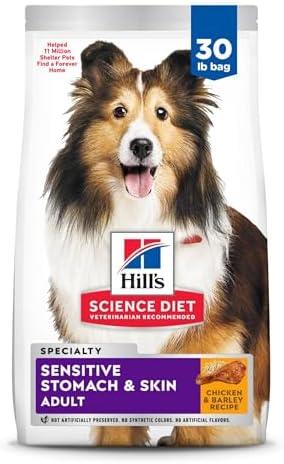When Sarah adopted Max, her energetic Labrador, she was excited to provide the best care. After a few months, she decided to switch his dog food for a brand she heard was healthier. However, she didn’t transition gradually. Within days, Max experienced digestive issues. This taught Sarah an important lesson: switching dog food isn’t just a simple task. It requires a careful approach to avoid upsetting your pet’s stomach. Always consult your vet and make changes slowly to ensure your furry friend stays happy and healthy!
Contents
- Understanding the Importance of Gradual Transition in Dog Food Changes
- Identifying Signs That Your Dog May Benefit from a New Diet
- Evaluating the Nutritional Quality of Different Dog Food Brands
- Expert Recommendations for Safely Switching Your Dog’s Food
- Q&A
Understanding the Importance of Gradual Transition in Dog Food Changes
When considering a change in your dog’s diet, it’s crucial to recognize that a sudden switch can lead to a host of digestive issues. Dogs, much like humans, can experience gastrointestinal distress when introduced to new foods too quickly. This can manifest as symptoms such as vomiting, diarrhea, or loss of appetite. To avoid these uncomfortable situations for your furry friend, a gradual transition is essential.
Implementing a slow change allows your dog’s digestive system to adjust to the new ingredients and nutritional profile. A well-planned transition typically spans over a week or more, depending on your dog’s sensitivity. This method not only minimizes the risk of digestive upset but also helps you monitor your pet for any adverse reactions to the new food. By observing your dog’s response during this period, you can ensure that the new diet is suitable for their needs.
To facilitate a smooth transition, consider the following steps:
- Start with a mix: Begin by mixing a small amount of the new food with the current diet, gradually increasing the proportion of the new food over several days.
- Monitor your dog: Keep an eye on your dog’s stool consistency and overall behavior throughout the transition period.
- Adjust as needed: If any signs of distress appear, slow down the transition process and give your dog more time to adjust.
Moreover, a gradual transition can enhance your dog’s acceptance of the new food. Dogs are creatures of habit, and a sudden change can lead to reluctance or refusal to eat. By slowly introducing the new food, you can make the experience more palatable and less stressful for your pet. This thoughtful approach not only promotes better health but also fosters a positive relationship between your dog and their meals.
Identifying Signs That Your Dog May Benefit from a New Diet
As a responsible pet owner, it’s crucial to pay attention to your dog’s health and well-being. If you notice any of the following signs, it may indicate that your furry friend could benefit from a change in diet:
- Weight Fluctuations: If your dog is gaining or losing weight unexpectedly, it could be a sign that their current food isn’t meeting their nutritional needs.
- Low Energy Levels: A sudden decrease in energy or playfulness may suggest that your dog is not receiving the right balance of nutrients.
- Digestive Issues: Frequent vomiting, diarrhea, or changes in stool consistency can indicate that your dog’s diet is not suitable for their digestive system.
- Skin and Coat Problems: If your dog is experiencing excessive itching, redness, or a dull coat, it may be time to reassess their food for potential allergens or deficiencies.
Behavioral changes can also be a significant indicator that your dog needs a dietary overhaul. If your pet seems more irritable, anxious, or less sociable than usual, consider evaluating their food. A well-balanced diet can have a profound impact on their mood and overall behavior.
- Increased Thirst: If your dog is drinking more water than usual, it could be a sign of an imbalanced diet that requires adjustment.
- Dental Health Issues: Bad breath, tartar buildup, or gum disease may suggest that the current food isn’t promoting good oral health.
- Age-Related Changes: Senior dogs often have different dietary needs. If your dog is aging, it may be time to switch to a formula designed for older pets.
Lastly, regular veterinary check-ups can provide valuable insights into your dog’s dietary needs. Your veterinarian can help identify any health issues that may be linked to their current diet and recommend appropriate alternatives. By staying vigilant and responsive to these signs, you can ensure that your dog receives the nutrition they need to thrive.
Evaluating the Nutritional Quality of Different Dog Food Brands
When considering a change in your dog’s diet, it’s essential to evaluate the nutritional quality of various dog food brands. Not all dog foods are created equal, and the ingredients can significantly impact your pet’s health and well-being. Look for brands that prioritize high-quality protein sources, such as real meat or fish, as the primary ingredient. This ensures that your dog receives the essential amino acids needed for muscle development and overall vitality.
Another critical factor to assess is the presence of whole grains or vegetables in the formula. These ingredients provide necessary fiber, vitamins, and minerals that contribute to a balanced diet. Avoid brands that rely heavily on fillers like corn or soy, as these can lead to nutritional deficiencies and digestive issues. Instead, choose options that include a variety of wholesome ingredients, such as:
- Brown rice – a great source of energy and fiber
- Sweet potatoes – rich in vitamins and antioxidants
- Peas – packed with protein and essential nutrients
Additionally, consider the brand’s commitment to transparency and quality control. Reputable manufacturers often provide detailed information about their sourcing practices and ingredient origins. Look for brands that conduct regular testing for contaminants and adhere to strict safety standards. This level of diligence not only reflects a commitment to quality but also ensures that your dog is consuming safe and nutritious food.
Lastly, don’t overlook the importance of tailored nutrition. Different breeds, ages, and health conditions require specific dietary considerations. Some brands offer specialized formulas designed for puppies, seniors, or dogs with specific health concerns, such as allergies or weight management. By selecting a dog food that meets your pet’s unique needs, you can help promote a longer, healthier life. Always consult with your veterinarian before making any significant changes to your dog’s diet to ensure the transition is smooth and beneficial.
Expert Recommendations for Safely Switching Your Dog’s Food
When considering a change in your dog’s diet, it’s essential to approach the transition with care. **Gradual changes** are key to preventing gastrointestinal upset. Start by mixing a small amount of the new food with your dog’s current food, gradually increasing the new food’s proportion over a week or two. This slow introduction allows your dog’s digestive system to adjust, minimizing the risk of diarrhea or vomiting.
Pay close attention to your dog’s **behavior and health** during the transition. Monitor for any signs of distress, such as changes in appetite, energy levels, or stool consistency. If you notice any adverse reactions, it may be necessary to slow down the transition or consult your veterinarian for guidance. Keeping a close eye on your pet’s response can help ensure a smooth switch.
Choosing the right new food is equally important. Look for options that are **high-quality and nutritionally balanced**. Consult with your veterinarian to determine the best food based on your dog’s age, weight, activity level, and any specific health concerns. A professional recommendation can help you avoid common pitfalls and ensure that your dog receives the nutrients they need.
Lastly, consider your dog’s **preferences and habits**. Some dogs may be picky eaters, while others may adapt quickly to new flavors and textures. If your dog seems resistant to the new food, try enhancing its appeal by adding a small amount of wet food or a tasty topper. This can make the transition more enjoyable for your furry friend and encourage them to embrace their new diet.
Q&A
-
Can I switch my dog’s food suddenly?
While it may be tempting to switch your dog’s food immediately, doing so can lead to digestive upset. It’s best to transition gradually over a week or so to allow your dog’s digestive system to adjust.
-
What is the best way to transition to a new dog food?
Start by mixing a small amount of the new food with the current food. Gradually increase the new food’s proportion while decreasing the old food over 7-10 days. This method helps prevent gastrointestinal issues.
-
Are there any signs my dog is having a bad reaction to new food?
Yes, watch for signs such as vomiting, diarrhea, excessive gas, or changes in appetite. If you notice any of these symptoms, consult your veterinarian and consider reverting to the previous food.
-
Is it necessary to consult a vet before changing dog food?
Consulting your veterinarian is highly recommended, especially if your dog has specific health concerns or dietary needs. A vet can help you choose the best food for your dog’s health and lifestyle.
while switching dog food can be beneficial, it’s essential to do so thoughtfully. Consult your veterinarian, transition gradually, and monitor your dog’s response. A well-informed choice ensures your furry friend thrives on their new diet.

大家好,我是彼得潘,專業的手法身體治療師。我喜歡探索和研究各種主題,並透過與人工智慧的合作分享專業、實用、有趣的文章。我們定期進行人工審核,以確保內容的準確性。如果您發現文章中有任何不準確的地方,請隨時與我們聯繫,我們會及時糾正。您可以透過 [email protected] 與我們聯繫。



